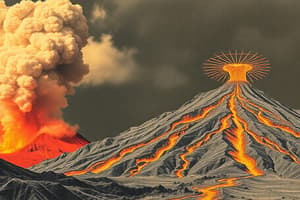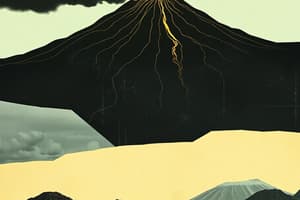Podcast
Questions and Answers
What is indicated by the glow of a volcanic crater?
What is indicated by the glow of a volcanic crater?
- Activity of magma (correct)
- Increase in freshwater sources
- Presence of solid rock
- Reduction in steam emission
What should NOT be included in your emergency supply kit when preparing for a volcanic eruption?
What should NOT be included in your emergency supply kit when preparing for a volcanic eruption?
- Heavy furniture (correct)
- First-aid kit
- Clean clothes
- Battery-operated radio
Which color represents an active volcano on monitoring maps?
Which color represents an active volcano on monitoring maps?
- Yellow
- Green
- Orange (correct)
- Red
What is a common precaution to take if instructed to stay indoors during a volcanic event?
What is a common precaution to take if instructed to stay indoors during a volcanic event?
Landslides and rockfalls around a volcano can occur due to what?
Landslides and rockfalls around a volcano can occur due to what?
Which of the following is NOT a characteristic of a potentially active volcano?
Which of the following is NOT a characteristic of a potentially active volcano?
How should livestock be secured before a volcanic eruption?
How should livestock be secured before a volcanic eruption?
What should you do if local authorities issue an evacuation order?
What should you do if local authorities issue an evacuation order?
What is the primary difference between lava flows and pyroclastic flows?
What is the primary difference between lava flows and pyroclastic flows?
What are lahars?
What are lahars?
Which of the following is NOT considered a sign of an impending volcanic eruption?
Which of the following is NOT considered a sign of an impending volcanic eruption?
What type of volcanic hazard is primarily composed of sulfur dioxide and hydrogen sulfide?
What type of volcanic hazard is primarily composed of sulfur dioxide and hydrogen sulfide?
What distinguishes tephra from other volcanic materials?
What distinguishes tephra from other volcanic materials?
Which volcanic hazard is characterized by a fast-moving mass of rock fragments and gases?
Which volcanic hazard is characterized by a fast-moving mass of rock fragments and gases?
What appropriate intervention should be taken during a volcanic eruption?
What appropriate intervention should be taken during a volcanic eruption?
What is the primary cause of the pressure build-up that leads to a volcanic eruption?
What is the primary cause of the pressure build-up that leads to a volcanic eruption?
Flashcards are hidden until you start studying
Study Notes
Volcano-Related Hazards
- Volcanoes are openings in the Earth’s crust allowing magma, ash, and gases to escape due to pressure build-up.
- Hazards include lava flows, ash fall, pyroclastic flows, lahars, and volcanic gases, each posing unique threats to life, property, and the environment.
Types of Volcano Hazards
- Lava Flow: Molten rock flowing from a volcano; denser and moves slower than pyroclastic flow.
- Ash Fall: Pulverized rock and glass ejected explosively, can blanket surrounding areas disrupting air quality and causing structural damage.
- Lahar: Mixture of water and volcanic materials flowing rapidly down slopes, highly destructive to infrastructure and landscapes.
- Pyroclastic Flow: Fast-moving mixture of gases and rock fragments; can cause extensive destruction due to high speeds.
- Tephra: Solid fragments ejected during eruptions, capable of causing injuries and damaging properties.
- Volcanic Gases: Emissions like sulfur dioxide and hydrogen sulfide are toxic and hazardous to health.
Signs of an Impending Eruption
- Increased frequency of small earthquakes and tremors may indicate rising magma.
- Ground deformation, such as tilting or cracks, suggests significant geological activity.
- Elevated volcanic gas emissions and temperatures may signal magma approaching the surface.
- Visible glow from a volcanic crater due to magma presence.
- Increased steam from fissures or hot springs.
- Thermal changes in the environment surrounding the volcano.
- Alterations in vegetation color and local water bodies.
- Occurrence of landslides unrelated to rainfall.
- Drying of local freshwater sources.
Understanding Volcano Hazard Maps
- Active Volcanoes: Marked with orange triangles, have erupted in the last 600 years and are actively monitored.
- Potentially Active Volcanoes: Denoted by yellow triangles, no current eruptions but may have a high likelihood of future activity.
- Inactive Volcanoes: Represented by green circles, these have no historical eruptions and are considered dormant or extinct.
Emergency Preparedness Measures
- Stay informed through local news and community warning systems regarding volcanic activity.
- Create a comprehensive emergency plan with family members, including designated meeting points.
- Prepare an emergency supply kit with essentials: first-aid supplies, food, water, flashlight, radio, medicines, masks, goggles, and sturdy clothing.
- Keep important items in waterproof containers for protection.
- Secure livestock in shelters prior to any eruption possibility.
During a Volcanic Eruption
- Follow evacuation orders and remain in designated shelters until further notice.
- If instructed to stay indoors, use damp cloths on windows and doors to prevent ash entry.
- Wear protective clothing, including long sleeves and pants, to reduce ash exposure.
- Use goggles and masks to protect against eye and respiratory hazards from volcanic particles.
- Stay updated through battery-operated radios for emergency information.
Post-Eruption Safety
- Monitor local news for updates on hazards and recovery efforts.
- Assess damage carefully and avoid areas deemed unsafe by authorities.
- Engage with community recovery programs and support services as needed.
Studying That Suits You
Use AI to generate personalized quizzes and flashcards to suit your learning preferences.




